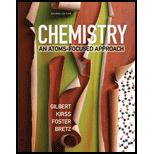
To find:
We need to find the equilibrium concentration of
Answer to Problem 14.101QA
Solution:
The equilibrium concentrations for all the species in the given reaction are:
Explanation of Solution
1) Concept
The system initially contains no product. This means that the reaction quotient
Let x be the increase in the concentration of
2) Given:
An equilibrium reaction equation for formation of nitrogen trioxide is given as:
i)
ii) Volume of flask is
iii) Initial mass of
iv) Initial mass of
3) Formula
i)
Where
ii)
iii)
4) Calculations:
Initial concentration of reactants is calculated as follows,
Number of moles of
Number of moles of
Drawing the RICE table:
| Reaction | |||
| Initial (M) | |||
| Change (M) | |||
| Equilibrium (M) | |||
Inserting the equilibrium terms into the equilibrium constant expression for the reaction gives,
Solving for x gives
The equilibrium concentration of
The equilibrium concentration of
Thus, equilibrium concentrations for the species
Conclusion:
Using the value of x in the terms in the Equilibrium row of the RICE table, we find the equilibrium concentration of
Want to see more full solutions like this?
Chapter 14 Solutions
CHEMISTRY:ATOMS-FOCUSED..-ACCESS
 ChemistryChemistryISBN:9781305957404Author:Steven S. Zumdahl, Susan A. Zumdahl, Donald J. DeCostePublisher:Cengage Learning
ChemistryChemistryISBN:9781305957404Author:Steven S. Zumdahl, Susan A. Zumdahl, Donald J. DeCostePublisher:Cengage Learning ChemistryChemistryISBN:9781259911156Author:Raymond Chang Dr., Jason Overby ProfessorPublisher:McGraw-Hill Education
ChemistryChemistryISBN:9781259911156Author:Raymond Chang Dr., Jason Overby ProfessorPublisher:McGraw-Hill Education Principles of Instrumental AnalysisChemistryISBN:9781305577213Author:Douglas A. Skoog, F. James Holler, Stanley R. CrouchPublisher:Cengage Learning
Principles of Instrumental AnalysisChemistryISBN:9781305577213Author:Douglas A. Skoog, F. James Holler, Stanley R. CrouchPublisher:Cengage Learning Organic ChemistryChemistryISBN:9780078021558Author:Janice Gorzynski Smith Dr.Publisher:McGraw-Hill Education
Organic ChemistryChemistryISBN:9780078021558Author:Janice Gorzynski Smith Dr.Publisher:McGraw-Hill Education Chemistry: Principles and ReactionsChemistryISBN:9781305079373Author:William L. Masterton, Cecile N. HurleyPublisher:Cengage Learning
Chemistry: Principles and ReactionsChemistryISBN:9781305079373Author:William L. Masterton, Cecile N. HurleyPublisher:Cengage Learning Elementary Principles of Chemical Processes, Bind...ChemistryISBN:9781118431221Author:Richard M. Felder, Ronald W. Rousseau, Lisa G. BullardPublisher:WILEY
Elementary Principles of Chemical Processes, Bind...ChemistryISBN:9781118431221Author:Richard M. Felder, Ronald W. Rousseau, Lisa G. BullardPublisher:WILEY





